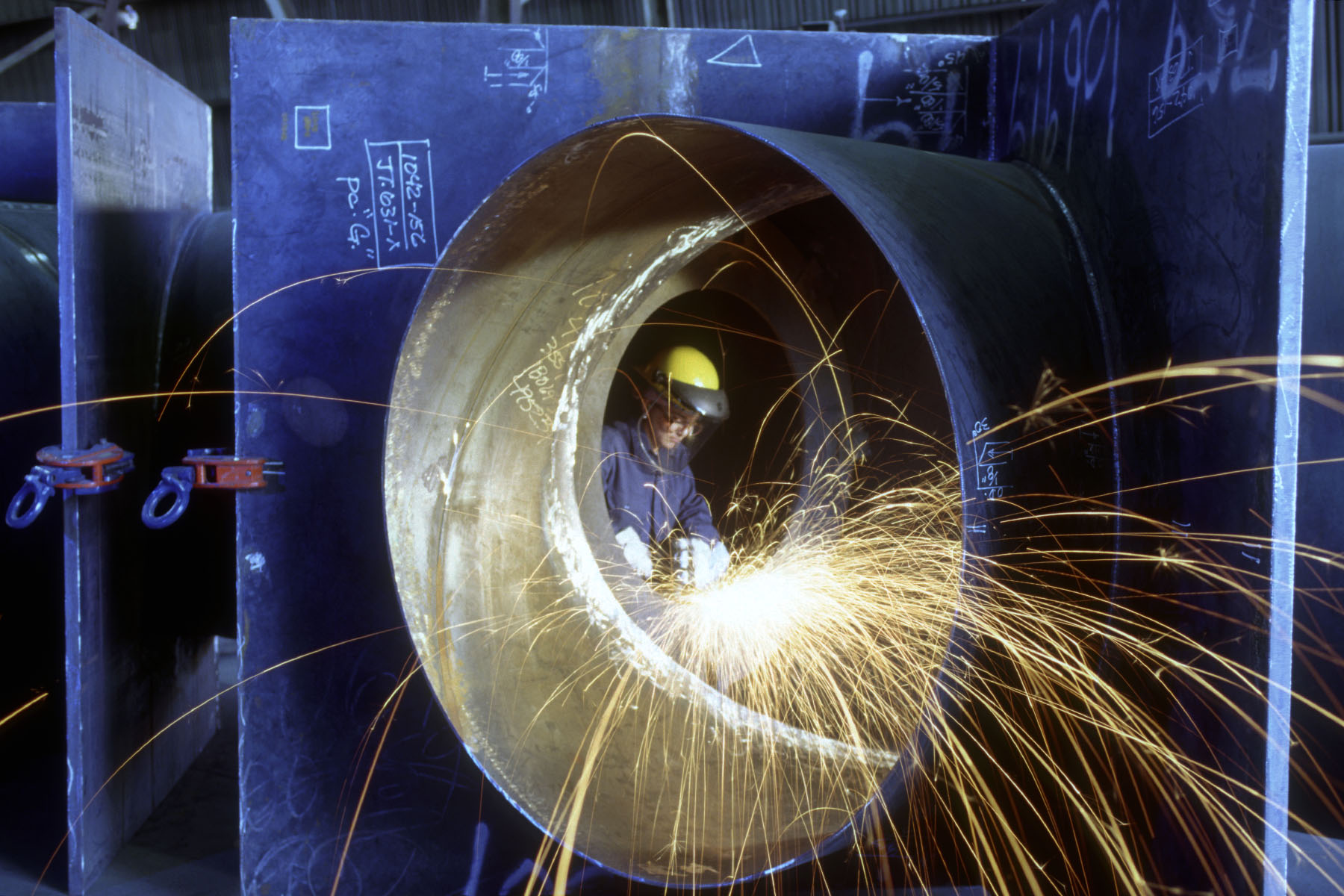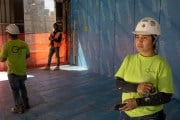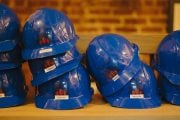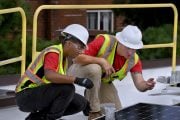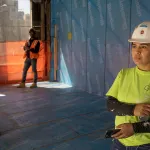We’re telling the untold stories of women, women of color and LGBTQ+ people. Sign up for our daily newsletter.
When Brianna Ernst steps onto a job site, she is already an anomaly: She’s a woman in the construction industry, a field dominated by men. But the protective gear she has to wear to work makes her stand out even more.
As a geologist at an engineering firm in the Chicago suburbs, most of her job is spent overseeing soil investigations for big projects, which involves field visits to construction sites, where her company drills anywhere between 50 to 100 feet into the ground to better understand the soil composition.
Currently, Ernst is working on electrical substations, which means she’s required to wear flame-resistant safety gear. Because there are so few women in this line of work, it was hard for her company to find flame-resistant gear that would fit her. Initially they gave her men’s pants and a couple of men’s shirts.
“I have a very small frame,” she said. “I’m wearing small sizes for men, but they’re still huge.”
The result is that the clothes meant to protect her are not doing their job well: Her too-long sleeves could get caught up in machinery, a dangerous worksite hazard. Since she is in a supervisory position, the safety aspect doesn’t bother Ernst as much. But the ill-fitting personal protective equipment (PPE) does impact her confidence in a field where she already has to prove herself more than her peers.
“I’m showing up to this client site in clothes that are too big for me, and it’s kind of embarrassing,” she said. “I look like this little girl who doesn’t belong. I’m not even wearing clothes that fit me.”
Already the construction trades are a tough industry for women and LGBTQ+ people due to persistent issues with sexism and discrimination. Only 4 percent of construction trade workers are women, and those who stay in the field often find the lack of PPE suited to their bodies frustrating — and yet another barrier they have to navigate in order to do their jobs.
-
Read Next:
Personal protective equipment — from helmets to steel-toed boots, safety harnesses, respirators and vests — has one main purpose: to keep workers safe on job sites. Heavy equipment, exposure to chemicals, working with heavy materials like steel and wood, and certain jobs like welding or electrical work put employees at significant risk of injury.
As of 2022, the construction and extraction fields have the second highest number of workplace deaths in the country at 951 fatalities, according to the Bureau of Labor Statistics. The BLS also reported 21,400 nonfatal injuries due to falls, slips and trips in 2020.
The issue varies across the construction industry, with women in every trade — metal fabricators, welders or electricians, carpenters, and fire alarm technicians — facing problems with their PPE not fitting correctly either because of size or different body types and exposing themselves to an increased risk of getting injured at work.
When The 19th asked women and LGBTQ+ people what their experiences with PPE were in the field, several pieces of equipment kept coming up: fall harnesses that don’t fit properly, high visibility safety vests that are too big, and equipment like gloves only being stocked in large and extra large sizes.
Sometimes the PPE that is geared toward tradeswomen can also make them feel like they stand out even more. Rachel Martino, a metal fabricator based in Baltimore, said she’s had issues with finding gloves small enough for her hands. A student in a metal shop she works at recently tried to be helpful by showing her a website that stocked women’s options. Everything was pink.
“It was a little bit discouraging in that case, because it’s like particularly at my fabrication job, I don’t want to draw any attention to the fact that I’m already a very small woman,” she said. “I don’t feel I need to have pink gloves on as well.”
Quinn Watson, a welder in Missouri, says as a petite nonbinary person one of their biggest issues is finding gloves and welding sleeves that fit. The PPE vending machine at work usually keeps more large and extra large gloves in stock, while only having a few sets of small gloves.
“I am not built like a train like most of the guys I work with, I’m built like a spaghetti noodle, so I need smaller fitting stuff,” she joked.
There have been times when there are no gloves in their size available at work, so she’s resorted to wearing old gloves with holes in the fingertips or gloves that are way too big.
-
Read Next:
“I have to do a lot of grinding and I use cutting wheels and things like that. So the gloves that are bigger and don’t fit me properly, it’s a lot easier for me to get them caught on something,” they said. “I’ve had enough experience that I know how to work with them and keep myself safe, but it’s something that can end up being a safety hazard.”
The sleeves are one size fits all, and are made out of a flame-resistant material that has elastic at the top near the shoulder and at the bottom near the wrist to hold them in place. They slide up the arm and protect against sparks and stray metal pieces that fly off in the welding process, but also from flash burn — an exposure to UV rays that can cause sunburns and puts workers at risk of skin cancer. But one size fits all doesn’t work for Watson.
“They always are falling off my arm. So I have to finagle them and use safety pins and stuff like that to make them stay on my arm so I don’t burn my arms while I’m working,” she said.
Inevitably there are times when she gets too annoyed to stop every time her sleeve falls down, exposing herself to injury.
Many other women interviewed for this piece expressed a similar dilemma. They can either wear PPE that in some cases can actually make the job feel less safe, or simply take it off to get the job done and risk the associated hazards.
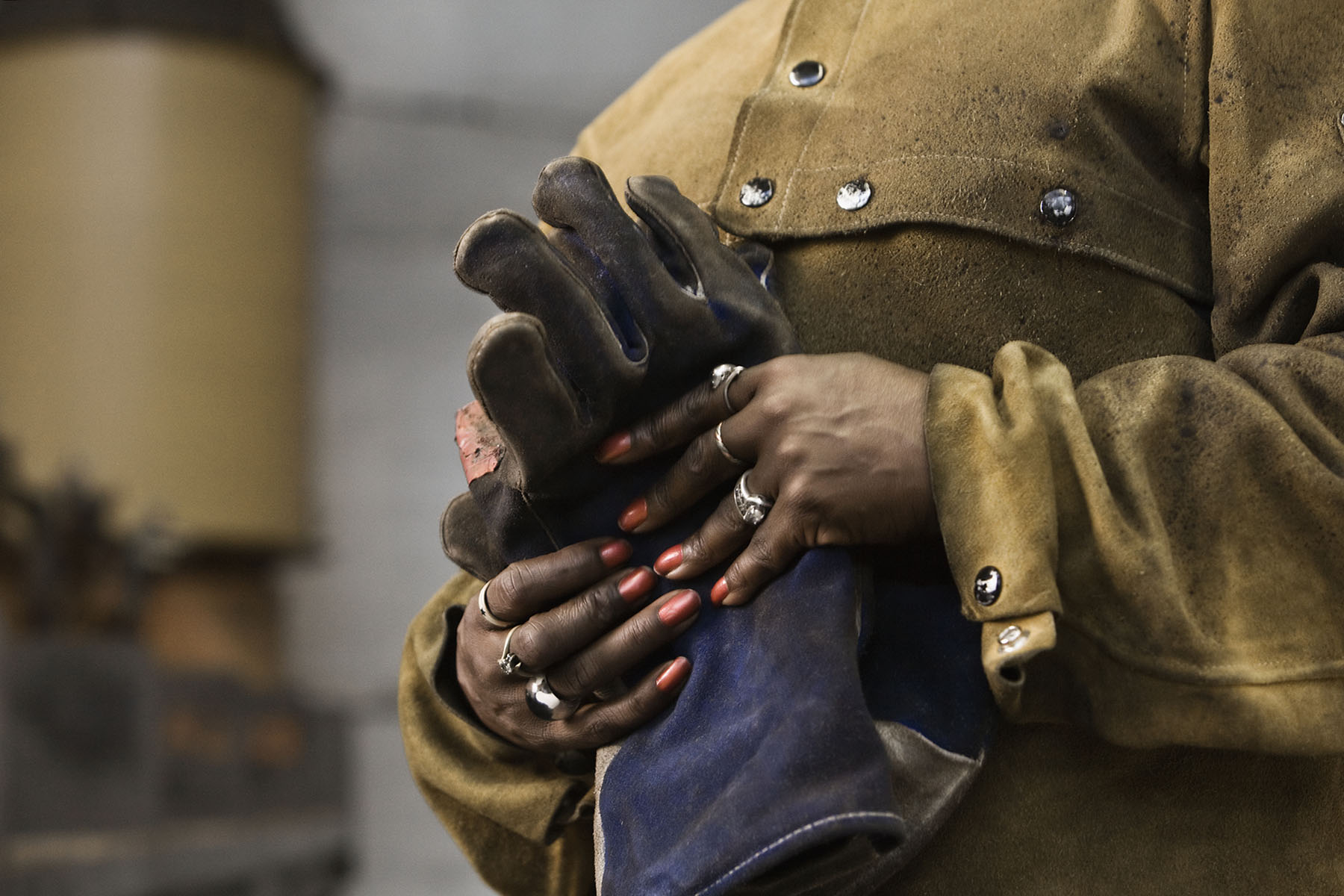
Tradeswomen living in San Francisco and Phoenix who spoke to The 19th are trying to work on solving this problem through newly formed women’s committees at their local unions, where in addition to working on things like better parental leave policies, they’ve discussed how to tackle the issue of PPE that doesn’t fit.
Xan Folmer, a union steward for the International Brotherhood of Electrical Workers Local 640 in Phoenix, said women on her committee — called sisters in the IBEW — have expressed a host of issues with helmets, gloves and fall harnesses. The union is currently in talks with the National Electrical Contractors Association to see if they can include in their contracts more specific requirements around providing PPE that fits them.
One particular PPE of concern are fall harnesses, Folmer said, a piece of gear brought up numerous times by tradeswomen in the course of reporting this story. It’s one example of PPE that can’t just be shrunk down in size, but needs to account for differences in women’s and men’s bodies.
Fall harnesses are worn on job sites when workers are at risk of falling from things like lifts or scaffolds. It is extremely important that they fit right in the event of an accident. The men’s version of the harness requires the wearer to place a strap directly across their chest. Because this is usually impossible or very uncomfortable for people with breasts, they often will wear the strap below or above their breasts, making the harness less safe.
Women’s versions do exist, but it can be an upward battle to get companies to provide them. Folmer said that at her current job with Rosendin Electric, one of the largest electrical contractors in the country, she went so far as to give a presentation on women’s fall harnesses to the safety department.
She explained to the department that the harnesses could cause major damage to breast tissue if a worker fell. “I was like, ‘I really don’t want someone to have to get a mastectomy,’” she said.
Her company listened and has since invested in women’s fall harnesses as a result of her speaking up.
“On the one hand, it’s kind of ridiculous that I had to [give that presentation]. We had women in the safety department that should know this, but they didn’t realize [the women’s harnesses] existed either,” she said. “On the other hand, the safety department was actually super receptive.”
Another common issue is the size of high visibility vests, which workers wear on job sites to avoid being hit by equipment. In the course of this reporting, women said they were given vests that are so large they catch on corners, or in one case a ladder, preventing the worker from safely descending until another employee could untangle them. Even when they request smaller sizes or vests designed for women, they can take months to arrive, because often contractors want their name printed on the clothing.
Jess, a Portland-based tradeswoman who for privacy reasons didn’t want her full name used, said the high visibility vest she was provided at Amazon was so big that it felt like a hazard to wear.
“I end up wearing a high visibility vest that is so loose it’s dangerous if I’m driving a forklift, or loading a moving belt that wearing it could be worse than not wearing it at all.”
There are many factors at play that make it difficult for women to get the PPE they need. For one, there are so few women in the industry that sometimes employers don’t want to invest money in gear for the sole woman who might need it, said Amy Roosa, who has worked in safety compliance for 19 years in various industries.
In some cases, companies want to do the right thing, but have a hard time finding women-specific gear through their vendors. Ernst, for example, is currently working with her employer to find other options, or even see if a tailor could help with certain clothing. In a lot of cases women have had to source their own PPE themselves, though many workers interviewed by The 19th said their employers often provided reimbursement.
Roosa, who is also the founder of The Safety Rack, her personal undertaking to review PPE for women in the trades using social media like Instagram, said that even though cottage industries have popped up aimed at providing well-fitting PPE for women, they have a hard time getting it in front of companies and employers and even workers who don’t know it exists.
-
Read Next:
“I know of several brands where they reached out to big distributors that could get their product out to market. They get crickets or a ‘No, we don’t want this product because there’s not a need for it,’” Roosa said.
But she points out that, not only is there a need for it, it would benefit people of all genders if it was stocked. “We have women and men of both sizes that need to be fitted for smaller and larger garments outside of the normal, medium to extra large that we traditionally see.”
The Department of Labor recently announced a proposed rule that would fall under the Occupational Safety and Health Administration (OSHA) that could get to some of these concerns. It would clarify that PPE has to properly fit workers in the construction industry. The comment period for the new rule closes on September 18. Vernon Preston, OSHA directorate of construction, said there is no set date for when the rule would be finalized.
“It is a goal of this administration to have a more equitable society that includes a more equitable workplace, and while OSHA isn’t making a new requirement, this clearer statement that PPE must fit properly will help ensure that workers of larger statures and smaller statures and that includes some women have properly fitting PPE,” Preston said.
Some tradeswomen, like Jess, are skeptical about the ability of OSHA to enforce this rule. In her experience, while she did see more OSHA compliance at large companies, government sites or on union jobs, on small job sites, where a lot of construction work happens, “It’s rare that I even see anybody caring about PPE,” she said. She felt even at the bigger sites, companies usually knew when OSHA was coming for an inspection.
Other tradeswomen, like Erin Toth, an electrician and union member in San Francisco, are optimistic that the new rule could have an impact.
“Every rule that the government makes, makes things a little easier for us to say, ‘Hey, I need this. And by the way, there’s a law about it,’” she said. “It gives us a stronger platform. It means we’re not fighting on our own anymore.”
